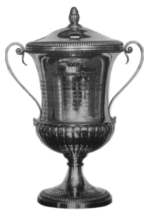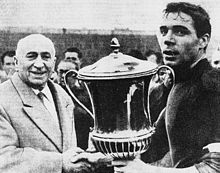
The Hungary national football team represents Hungary in men's international football, and is controlled by the Hungarian Football Federation. The team has made nine appearances in the FIFA World Cup, and five in the UEFA European Championship. Hungary plays their home matches at the Puskás Aréna, in Budapest, which opened in November 2019.

The Czechoslovakia national football team represented Czechoslovakia in men's international football from 1919 to 1993. The team was controlled by the Czechoslovak Football Association, and the team qualified for eight World Cups and three European Championships. It had two runner-up finishes in World Cups, in 1934 and 1962, and won the European Championship in the 1976 tournament.
The Balkan Cup was an international association football competition contested on and off from 1929 to 1980 by countries from the Balkans region. The most successful team was Romania with four titles.
The European International Cup of Nations was an international football competition held by certain national teams from Central Europe & South Europe between 1927 and 1960. There were competitions for professional and amateur teams. Participating nations were: Italy, Austria, Czechoslovakia, Hungary, Switzerland, Poland, Romania, and Yugoslavia. Poland and Romania only competed in the amateur competition.
The 1934 FIFA World Cup was the first World Cup for which teams had to qualify, after the finalists in the inaugural 1930 World Cup had participated by invitation from FIFA. With 32 teams having entered the 1934 competition, FIFA organized qualification rounds to select 16 teams for the finals. Even Italy, the host of the World Cup, had to earn its spot, the only time this has been the case. The previous champion Uruguay refused to defend its title because many European nations had declined to take part in the 1930 World Cup, held in Uruguay.
A total of 37 teams entered the 1938 FIFA World Cup qualification rounds, competing for a total of 16 spots in the final tournament. For the first time the title holders and the host country were given automatic qualification. Therefore, France, as the hosts, and Italy, as the defending champions, qualified automatically, leaving 14 spots open for competition.

HŠK Građanski, also known as 1. HŠK Građanski or fully Prvi hrvatski građanski športski klub, was a Croatian football club established in Zagreb in 1911 and dissolved in 1945. The club had a huge influence on the development of football in Croatia and Kingdom of Yugoslavia and achieved its greatest success in the period between the two World Wars.

György Sárosi was a Hungarian footballer. Sárosi was a complete footballer renowned for his versatility and technique among other things, and he played in several positions for Ferencváros and the Hungary national team. Essentially a second striker, he could also operate in midfield or central defence, and he helped Ferencváros win five Hungarian league titles between 1932 and 1941. He is considered one of the greatest players of the pre-war era.

Karel "Káďa" Pešek was a Czechoslovak ice hockey and football player. He played as midfielder for Sparta Prague and the Czechoslovak football national team. He played from 1913 to 1933, scoring 149 goals in his club career. Pešek was voted by IFFHS as the 81st greatest European footballer of the 20th century, and the third greatest Czechoslovakian player of the 20th century behind Josef Bican and Josef Masopust.

Géza Kalocsay was a footballer and manager from Hungary who played internationally for both Czechoslovakia and Hungary.
Vilmos Sipos, also known as Vilim Šipoš and Willy Sipos was a Hungarian football player and manager. He played for several important clubs in a number of countries, having represented at national level both Yugoslavia and Hungary.
The 1933 season of the Mitropa Cup football club tournament was won by Austria Wien who defeated AS Ambrosiana Inter 4–3 on aggregate in the final. It was the third time that a team from Vienna won the tournament, but the first of two wins for FK Austria Wien. The two legs were played on 3 September in Arena Civica in Milan and 8 September in Prater Stadium. The second leg of the final was decided when the referee didn't convalidate a goal that would equalize the game from Giuseppe Meazza and shortly after that ejected Luigi Allemandi and Atilio Demaría that left Inter with 9 men.
The 1967–68 Mitropa Cup was the 28th season of the Mitropa football club tournament. It was contested by sixteen clubs from 15 European cities and 5 countries. Winner was Red Star Belgrade of Yugoslavia who beat Spartak Trnava of Czechoslovakia in the two-legged final 4–2 on aggregate. Notably, the first leg of the finals was scheduled to be held in Trnava on August 21, 1968, but was postponed due to the Warsaw Pact invasion of Czechoslovakia, which commenced on August 20, 1968 at 11 pm. The game was postponed and the final games were eventually held in October 1968.
The 1940 Mitropa Cup was the 14th edition of the Mitropa Cup and the last season played before the competition was interrupted by the Second World War. The competition would be resumed after the war under the name Zentropa Cup but by that time it was overshadowed by the newly formed European Cup which included teams from all parts of Europe. Last season's champions Újpest were eliminated at the quarter-final stage of the competition. This edition is notable for being the first edition in which a team from Romania reached the final. Rapid București of Romania beat Hungária FC MTK Budapest of Hungary in the quarterfinals and got past Građanski of Yugoslavia in the semi-finals to get to the finals in which they were to play Ferencváros. The final was cancelled due to the Second World War.
The 1939 season of the Mitropa Cup football club tournament was won by Újpest who defeated fellow Hungarian side Ferencváros 6–3 on aggregate in the final. It was the third consecutive final appearance for Ferencváros and it was Újpest's second and final victory in the competition.
The 1937 season of the Mitropa Cup football club tournament was won by Ferencváros who defeated Lazio 9–6 on aggregate in the final. It was their second victory in the competition, having previously won it in 1928. The two legs of the final were played on 12 September and 24 October.
Ferencvárosi TC is a Hungarian professional football club based in Ferencváros, Budapest. Ferencváros has been the most successful Hungarian club in European football competitions having won the 1964–65 Inter-Cities Fairs Cup.
Ferencvárosi Torna Club is a Hungarian professional football club based in Budapest, Hungary. They are the most decorated club in Hungary, in which they won a record of 31 national titles and 23 national cups.
This is a list of the Czechoslovakia national football team games between 1920 and 1938, as well as the games that the nation played as Bohemia between 1903 and 1908 and as Bohemia & Moravia in 1939.








